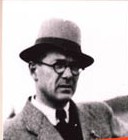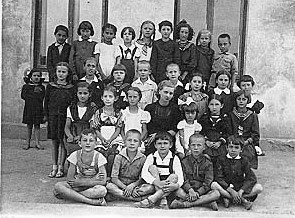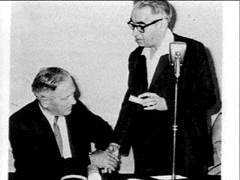Holocaust Education & Archive Research Team |
|
Einsatzgrϋppen
Einsatz Group A Einsatz Group B Einsatz Group C Einsatz Group D Babi Yar Articles Einsatz Leaders Einsatzgruppen Operational Situational Reports [ OSR's #8 - #195 ]
| |||
Hermann Graebe Evidence Testimony at Nuremberg War Crimes Trial
On 13 July 1942, Hermann Graebe, a German engineer of the firm Jung A.G, witnessed the round-up of Jews at Rowne ghetto in Volhynia, and he wrote this description of these tragic events:
He was in Rowne in order to prevent the deportation of a hundred Jews, employed in the engineering works of which he was the manager. Immediately after the war he recalled:
On the evening of this day, I drove to Rowne and posted myself with Fritz Einsporn in front of the house in the Bahnhofstrasse in which the Jewish workers of my firm slept.
Shortly after 2200 the ghetto was encircled by a large SS detachment and about three times as many members of the Ukrainian militia. Then the electric arc-lights which had been erected in and around the ghetto were switched on.
SS and militia squads of four to six men entered or at least tried to enter the houses. Where the doors and windows were closed and the inhabitants did not open at the knocking, the SS man and militia broke the windows, forced the doors with beams and crowbars, and entered the houses.
The people living there were driven on the street just as they were, regardless of whether they were dressed or in bed. Since the Jews in most cases refused to leave their houses and resisted, the SS and militia applied force. They finally succeeded, with strokes of the whip, kicks and blows, and rifle butts, in clearing the houses.
The people were driven out of their houses in such haste that small children in bed had been left behind in several instances. In the streets women cried out for their children and children for their parents.
That did not prevent the SS from driving the people along the road at running pace, and hitting them, until they reached a waiting freight train. Carriage after carriage was filled and the screaming of women and children and the cracking of whips and rifle shots resounded unceasingly.
Since several families or groups had barricaded themselves in especially strong buildings and the doors could not be forced with crowbars or beams, the doors were now blown open with hand grenades.
Since the ghetto was near the railroad tracks in Rowne, the younger people tried to get across the tracks and over a small river to get away from the ghetto area. As this stretch of country was beyond the range of the electric lights, it was illuminated by small rockets.
All through the night these beaten, hounded and wounded people moved along the lighted streets. Women carried their dead children in their arms children pulled and dragged their dead parents by their arms and legs down the road towards the train.
Again and again the cries, “Open the door, Open the door!” echoed through the ghetto. The words of Grabe’s affidavit, which froze the Nuremberg Court with horror and pity when read by Sir Hartley Shawcross on 27 July 1946, should in no respect be abridged.
“On the 5 October 1942, when I visited the building office at Dubno, my foreman told me that in the vicinity of the site Jews from Dubno, had been shot in three large pits, each about thirty metres long and three metres deep. About fifteen hundred persons had been killed daily. All were to be liquidated. As the shootings had taken place in his presence he was still very upset.
Moennikes and I went straight to the pits. Nobody prevented us. I heard a quick succession of shots from behind one of the mounds of earth. The people who had got off the lorries – men, women and children of all ages – had to undress upon the order of an SS man, who carried a riding or a dog whip. They had to put their clothes on separate piles of shoes, top clothing, and underclothing.
I saw a heap of shoes that must have contained eight hundred to one thousand pairs, great piles of clothes and undergarments. Without screaming or weeping these people undressed, stood in family groups, kissed each other, said their farewells, and waited for a sign form another SS man, who stood near the pit, also with a whip in his hand.
During the fifteen minutes that I stood near the pit, I did not hear anyone complain or beg for mercy. I watched a family of about eight, a man and a woman, both about fifty, with their children, aged about one, eight and ten, and two grown up daughters of about twenty to twenty –four.
An old woman with snow-white hair was holding the one-year old child in her arms, singing something to it and tickling it. The child was crowing with delight. The man and wife were looking on with tears in their eyes.
The father was holding the hand of a boy about ten, speaking to him softly. The boy was fighting back his tears. The father pointed to the sky, stroked the boy’s head and seemed to explain something to him.
At that moment the SS man at the pit shouted something to his comrade, who separated off about twenty persons and ordered them to go behind the mound of earth. Among them was the family I have mentioned.
I still clearly remember a dark- haired, slim girl who pointed to herself as she passed close to me and said, “Twenty-Three.” I walked to the other side of the mound and found myself standing before an enormous grave. The people lay so closely packed, one on top of the other, that only their heads were visible.
Nearly all had blood running over their shoulders from their heads. Some of them were still moving. Some lifted an arm and turned a head to show that they were still alive.
The pit was already two-thirds full. I estimated that it already contained about one thousand people. I looked round for the man who had shot them. He was an SS man who was sitting on the edge of the narrow end of the pit, his legs dangling into it. He had a sub-machine gun across his knees and was smoking a cigarette.
The people, completely naked, went down some steps which had been cut in the clay wall of the pit and climbed over the heads of those already lying there, to the place indicated by the SS man. They laid down in front of the dead or injured people. Some of them caressed those who were still alive and spoke to them softly.
Then I heard a series of shots. I looked into the pit and saw that the bodies were twitching or that the heads lay motionless on top of the bodies which lay before them. Blood was pouring from their necks.
I was surprised I was not ordered away, but saw there were also two or three uniformed policemen standing nearby. The next batch was already approaching. They climbed into the pit, lined up against the previous victims and were shot. When I walked back round the mound I noticed another lorry-load of people which had just arrived.
This time it included sick and infirm people. A very thin old woman, with terribly thin legs, was undressed by others who were already naked, while two people supported her. The woman appeared to be paralysed. The naked people carried the woman around the mound. I left with Moennikes and drove back to Dubno in the car.
On the morning of the next day, when I visited the site, I saw about thirty naked people lying near the pit- about thirty to fifty metres away from it. Some of them were still alive, they looked straight in front of them with a fixed stare and seemed not to notice neither the chillness of the morning nor the workers of my firm who stood around.
A girl of about twenty spoke to me and asked me to give her clothes and help her escape. At that moment we heard a fast car approach and I noticed it was an SS detail. I moved away to my site. Ten minutes later we heard shots from the vicinity of the pit. Those Jews who were still alive had been ordered to throw the corpses into the pit, then they themselves had to lie down in the pit, to be shot in the neck.
Sources:
Hermann Graebe testimony at IMT Nuremberg on 10 November 1945 and 13 November 1945 Nuremberg Document PS – 2992. The Final Solution by G. Reitlinger – Vallentine Mitchell &Co Ltd 1953. The Holocaust – The Jewish Tragedy by Sir Martin Gilbert published by Collins London 1986.
COPYRIGHT: CW H.E.A.R.T 2007
|




